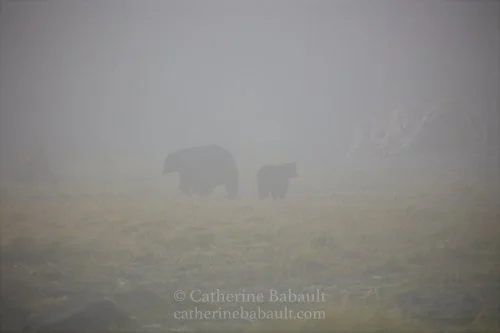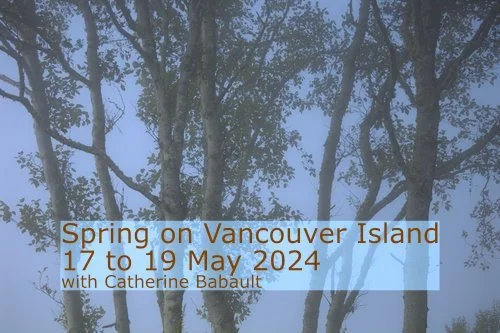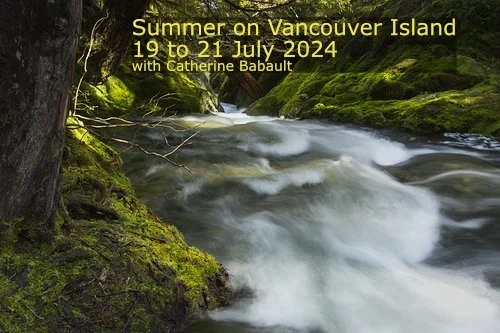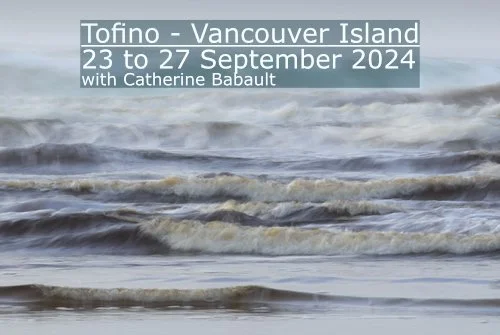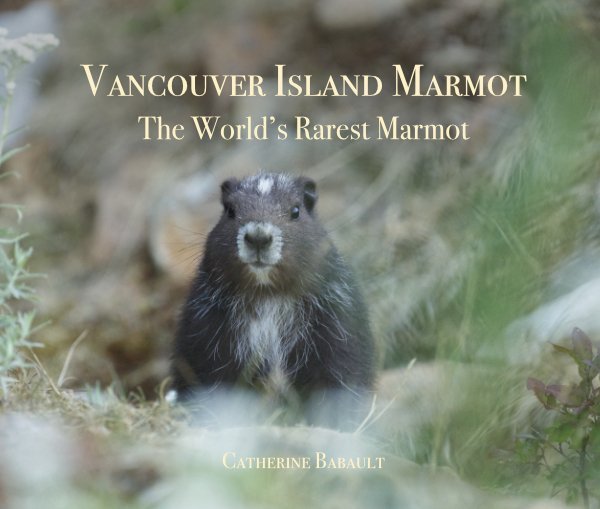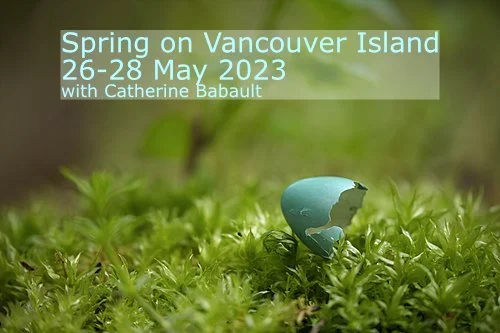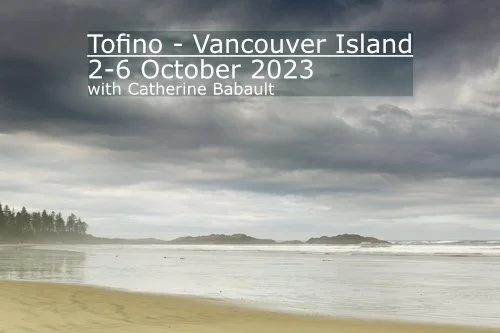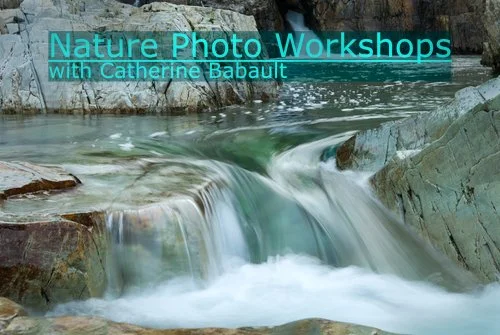Unique photo opportunities to capture black bears catching salmon, Roosevelt elk herds during the rutting period, and sea lions gatherings to feed along the coast.
Vancouver Island is a stopover on the Pacific Flyway whereas some birds choose to winter on the island such as trumpeter swan, long-tailed duck and surf scoter.
Lower light conditions are better for nature photography.
Fall is a display of vibrant colours in the rainforest while winter offers misty landscapes and waves crashing on the rugged shoreline during storms.
The shoulder season is a great time to enjoy the tranquility in the forest and take the time to create your best images. It is also cheaper to travel.
Photographing the coastal black bear
As a wildlife photographer, I enjoy learning about wild animals and observing them in their natural environment. While some photographers are interested in birds, I prefer mammals. Big mammals, like bears. Their large size, curvy shape and thick fur make them both attractive and intimidating.
I saw my first black bear in Manitoba during a solo road-trip across the country. I was driving on a rural road when suddenly a chunky bear crossed the road and dashed into the woods. It was a brief encounter but I was delighted. After settling on Vancouver Island, I became aware that bears are everywhere. They frequent the mountains, coastal rainforests and towns. I also learnt that black bears can swim, climb trees, and break into homes and vehicles. I had moved to bear country.
After learning about bear safety, my next step was to capture their natural behaviour in their natural habitat. However, I had to find the right balance between reaching my goal and minimizing my impact on the animals, which meant I had to keep a safe distance and avoid disrupting their activities. The other factors I had to consider were the location and accessibility, the time of the year, the light, and the setting. After spending an extensive period of time researching at home and exploring in the field, I found a remote prime fishing spot used by black bears during the salmon run. By the time I first visited that spot, I had encountered many black bears around Vancouver Island, so I was familiar with their behaviour and I knew how to read their body language.
Mama bear and her cub on a foggy morning, Vancouver Island, British Columbia.
One morning, when I arrived at that fishing spot, it was entirely wrapped in thick fog and the visibility was greatly reduced. I could see dark rounded shapes here and there on the shoreline, but I could only determine whether it was a bear or a big boulder when it started to move. It was a surreal experience. One by one, bears came out of the rainforest and nonchalantly walked to a pool of water filled with salmon. Once they caught a fish, they walked back to the forest where they ate their tasty meal in peace. They mostly came alone but sometimes a mother bear was accompanied by her cubs. The time passed slowly as I waited for them to appear and disappear through the dense fog. I felt privileged to be in the presence of such an incredible animal.
A coastal black bear during the salmon run on Vancouver Island, British Columbia.
There were other extraordinary moments. One day, I watched a teenage bear challenging authority. He reminded me as a teenager. He wanted access to the best fishing spot but a dominant sow was already there. Determined to get a salmon, he approached the spot knowing perfectly well that he was challenging her dominant place in the hierarchy. She ignored him so the intrepid yearling decided to get even closer. Annoyed by his persistence, she got up and briefly chased him. Startled, he ran away but he had forgotten where I was and he was coming towards me. So I had to tell him to back off in a stern voice. Surprised to find me in his way, he stopped, turned around and walked away.
I like observing the different characters in animals, especially bears. Some are shy, others are bold and curious. They are not that different from us. I have witnessed cubs fighting over a big salmon their mother had caught for them. At only a few months old, they were already demonstrating distinctive traits.
There are more stories like these in my book Wild Vancouver Island. It features several species such as Roosevelt elk, Vancouver Island marmots, sea otters, humpback whales and many other mammal and bird species. Working as a wildlife photographer has its challenges but it is also rewarding. When I have the privilege of having a glimpse into the lives of wild animals in their natural environment, I tend to forget all the time I spent waiting for them in the rain, fog or cold. Every year, I look forward to the salmon run and my trip to that special place, where I can spend days watching and photographing the coastal black bear.
2024 Herring Spawn on Vancouver Island
This year again I am keeping a close eye on the herring spawn in shallow waters on the coast of Vancouver Island. This is an exciting time for wildlife photographers as many species such as orcas, seals, sea lions, bald eagles and many other birds gather for the feast.
Join me on a daily tour in March. This is a popular photo tour, book early or ask me for a private photo tour at a time convenient for you.
We will start early in the morning and spend the day on the shoreline when we could see lots of wildlife. Last year, we saw a pod of orca close to shore and also sea lions, seals, a mink and river otters as well as many birds.
I look forward to sharing this incredible event with you!
Photograph the Herring Spawn on Vancouver Island with professional photographer Catherine Babault
Vancouver Island Photo Tours and Workshops for 2024
I have been giving photo tours and workshops on Vancouver Island since 2018 and had the pleasure to meet photographers of all levels from North America and Europe.
As a professional nature photographer, I spend a lot of time in the field all year round tracking and photographing the great variety of wildlife and landscapes in this unique part of the world. I know the best places and times for nature photography and I’d love to show them to you.
Private nature photography tours and workshops all year round
If you’d like to book a private tour or workshop on Vancouver Island, contact me, I’ll be more than happy to prepare an itinerary for you based on your interests and experience in photography. I organize private tours and workshops (half day, full day, and multiple days), in English and in French (I am fluent in both languages).
Upcoming photo workshops in the field in 2024
Herring Spawn - Daily photo tours during the herring spawn. This spectacular annual event attracts a lot of wildlife on the coast. If you are a keen wildlife photographer, this workshop is for you. We could see sea lions, seals, whales (from the coast), minks, river otters, many many bird species such as bald eagles and great blue herons. Limited to 5 people per day. Sign up early!
Spring on Vancouver Island - Spring is a time of migration for thousands of birds and mammals on the island. During this three-day workshop, we’ll visit the shoreline, estuaries and forests with moss-covered trees where we could see a variety of wildlife such as owls, bald eagles, beavers, black-tailed deers, seals, sea lions, river otters and many other species. Sign up today.
Summer on Vancouver Island - The long days of summer provide plenty of time to go outside and explore the coastal rainforests and shorelines of the island. Wildlife is busy caring for their offspring and protecting their territory in the lush rainforest and on the coast. Limited to 5 participants, sign up today.
Tofino, Vancouver Island - Join me for a unique photo workshop in Tofino, on the wild west coast of Vancouver Island. Explore the amazing landscape of the Pacific Northwest: old-growth forests, moss covered trees in the temperate rainforest, stunning bluffs, and sandy beaches. Limited to 5 participants. Sign up early.
Fall on Vancouver Island - Fall is an exciting time for photographers and wildlife. Many birds pass through the region on route to their winter grounds or make Vancouver Island their temporary home. The salmon returns to its native springs to spawn and black bears take advantage of it to fatten up for winter. Meanwhile deciduous trees in the lush forests turn yellow, orange and red to the delight of photographers. This is a popular workshop, sign up early.
Limited Time Offer - Free Shipping
Free shipping in British Columbia and Alberta when you order my photo book Vancouver Island Marmot, the World’s Rarest Marmot. This offer ends on November 27, 2023. Enter promo code BCAB2023 at checkout.
Let me know if you’d like me to write a personal note when I sign the book.
Start your holiday shopping early, order a copy today!
“‘‘…Like Babault’s earlier book, this work is a feast for the eyes. The close-up images of marmots in the wild are charming, and the author’s keen artist’s eye has captured images of the steep mountain ridges, meadows and screes where the elusive rodents live that are delicate and colourful, evoking in their often fog-softened, flower-dotted beauty the works of the French Impressionists.’’”
Sustainable Photo Tours and Workshops on Vancouver Island
As the owner of a small business that offers photo tours and workshops on Vancouver Island, I am committed to supporting sustainable development:
During the tours, we photograph wildlife from a respectful and safe distance. The well-being and safety of wildlife has always priority over the photographic aspirations of the participants.
I educate participants about ethics in nature photography.
I share my knowledge about local wildlife and conservation projects.
I promote carpooling and limit the tours/workshops to five (5) persons.
I support local and sustainable businesses (hotels and tours operators).
I minimize waste by avoiding the use of non-recyclable containers for snacks and water.
These are only some of the activities that form part of my sustainable plan. Learn more.
Vancouver Island Photo Tours and Workshops for 2023, 2024 and 2025
On your visit to Vancouver Island, in British Columbia, join me for a photo tour or workshop. As a professional nature and wildlife photographer based on Vancouver Island, I know the best times and places to photograph nature far from the crowded touristic areas.
There are still spots available on photo workshops for this year, don’t miss your chance! You can also request a private tour or workshop at no extra cost, contact me to schedule yours. And if you like to plan in advance, I have added several photo workshops for 2024 and 2025.
Early birds get a free healthy lunch and a guaranteed spot!
2023
Half-day photo workshops in the Comox Valley
In English: 13 May, 17 June, 8 July, 12 August
In French: 20 May, 19 August
Three full days photo workshops in the field
Spring on Vancouver Island: 26 to 28 May
Summer on Vancouver Island: 21 to 23 July
Four days photo workshop in the field
Fall Colours on Vancouver Island: 12 to 15 October
Tofino
In French only: 18 to 22 September
In English: 2 to 6 October
2024
Half-day photo workshops in the Comox Valley
In English: 8 June, 17 August
In French: 4 May, 10 August
Full-day photo workshops in the field
Herring Spawn: 10 March
Herring Spawn: 13 March
Herring Spawn: 15 March
Three full days photo workshops in the field
Spring on Vancouver Island: 17 to 19 May
Summer on Vancouver Island: 19 to 21 July
Fall Colours on Vancouver Island: 18 to 20 October
Tofino: 23 to 27 September
2025
Half-day photo workshops in the Comox Valley
In English: 7 June, 16 August
In French: 3 May, 9 August
Full-day photo workshops in the field
Herring Spawn: 9 March
Herring Spawn: 12 March
Herring Spawn: 14 March
Three full days photo workshops in the field
Spring on Vancouver Island: 16 to 18 May
Summer on Vancouver Island: 18 to 20 July
Fall Colours on Vancouver Island: 17 to 19 October
Tofino: 22 to 26 September
Interview on CBC, North by Northwest
Sometimes we are lucky enough to be interviewed by a journalist we have admired for years. That's what happened to me when I was interviewed by Margaret Gallagher for North by Northwest, CBC Radio One in Vancouver. Despite being a little intimidated, I managed to speak more or less clearly about my Vancouver Island marmot photo book, which was released last December, and the conservation efforts to save the marmot from extinction.
I invite you to listen to the interview and order a signed copy of my book.
Parfois nous avons la chance d’être interviewé par une journaliste que nous admirons depuis des années. C’est ce qui m’est arrivé lorsque j’ai été interviewée par Margaret Gallagher pour l’émission North by Northwest, CBC Radio One à Vancouver. Malgré le fait que j’étais un peu intimidée, j’ai réussi à parler plus ou moins clairement de mon livre de photos sur la marmotte de l’île de Vancouver, paru en décembre dernier, et des efforts de conservation pour sauver la marmotte de l’extinction.
Je vous invite à écouter l’entrevue et commander une copie signée de mon livre.
Book Review in Vancouver Sun
My photo book Vancouver Island Marmot, The World’s Rarest Marmot received an incredible book review in this weekend edition of the Vancouver Sun. It is ‘‘highly recommended’’!
I am very grateful to Tom Sandborn for his kind words. Read his review.
Interviewed for Shaw TV Spotlight
I recently spoke with Gordon Darby, producer, Shaw TV Spotlight. We meet on a windy and cold day at a park in Courtenay to talk about my passion for wildlife photography, and particularly for the Vancouver Island marmot. You can watch the interview here.
J’ai récemment parlé avec Gordon Darby, producteur, Shaw TV Spotlight. Nous nous sommes rencontrés lors d’une journée venteuse et froide à un parc à Courtenay pour parler de ma passion pour la photographie animalière, et en particulier pour la marmotte de l’île de Vancouver. Vous pouvez voir l’entrevue en anglais ici.
Watch the herring spawn off the coast of Vancouver Island, BC
Every year, at the end of winter, schools of Pacific herring gather off the coast of Vancouver Island to spawn in shallow waters. This annual event attracts a lot of mammals and birds that feed on the fish and its eggs.
Perched on tall trees, bald eagles are keeping an eye on the action, ready for an opportunity to catch a herring or something else. Minks and river otters are also on the lookout for the silver fish while gulls bicker over their biggest catch. The sea lions are also here; they are hard to ignore with their constant barking. On the shoreline, curious seals are observing the action. The presence of sea lions and seals attracts larger predators such as the orca.
Join me for a photo workshop from 13 to 15 March to photograph this spectacular event.
Tours et ateliers de photographie sur l’île de Vancouver, Colombie-Britannique
Vous souhaitez en apprendre davantage sur les bases de la photographie de la nature ou simplement améliorer vos capacités. Mais avant tout, vous souhaitez vivre cette expérience en français.
Contactez-moi, je suis là pour vous !
Je donne des tours et des ateliers de photographie de la nature, sur le terrain sur l’île de Vancouver, à l’année longue. Le français est ma langue maternelle alors je serais ravie de partager ma passion pour la photo avec vous dans cette langue.
En plus, vous avez des options : vous pouvez vous inscrire à un atelier déjà au calendrier ou bien demander un tour/atelier à une date de votre choix, que ce soit une demi-journée, une journée entière ou plusieurs jours.
Amenez votre partenaire ou un(e) ami(e) avec vous, explorez la superbe île de Vancouver avec votre appareil-photo en mains, découvrez sa faune charismatique et repartez avec vos plus belles photos et un savoir pour votre prochain voyage.
Book a Nature Photography Workshop on Vancouver Island, British Columbia
A new year means new resolutions like traveling more or exploring new places, camera in hand.
On your visit to Vancouver Island, British Columbia, sign up for a nature photography workshop with a local photographer: me. Explore the rugged coastline and the temperate rainforest, capture unique species with your camera, and return home with compelling photos.
Tel que vu à CBC Radio-Canada
Réalisation et montage : Pierre Beaudoin, caméra : Alexandre Lamic, CBC Radio-Canada
Photo : Alexandre Lamic, Radio-Canada
L’automne dernier, j’ai eu le plaisir d’être filmée par CBC Radio-Canada sur le terrain sur l’Île de Vancouver. Au cours de l’entrevue, je parle d’espèces menacées dans la région et d’espèces à risque d’extinction comme la marmotte de l’Île de Vancouver. Je mentionne aussi l’importance de l’éthique dans la photographie de nature pour préserver le monde naturel; nous pouvons tous faire notre part en gardant une distance sécuritaire avec les animaux, en évitant de les déranger dans leur routine et en n’interférant pas avec leur habitat.
Je vous invite à regarder la vidéo ici.
As seen on CBC Radio Canada...
Production and montage: Pierre Beaudoin, camera: Alexandre Lamic, CBC Radio-Canada.
Photo credit: Alexandre Lamic, Radio-Canada
Last autumn, I had the pleasure of being filmed by CBC Radio-Canada in the field on Vancouver Island. During the interview, I talk about species of special concern in the region and endangered species like the Vancouver Island marmot. I also mention the importance of ethic in nature photography to preserve the natural world; we can all do our part by keeping a safe distance from wildlife, avoiding disturbing their routines and not interfering with their habitat.
I invite you to watch the video here.
Spot Distracting Elements
When I am on a photo excursion in the forest, the red-legged frog tends to appear when I least expect it. Their colour is an excellent form of camouflage. Often, it is their leap at my approach that catches my eye. During any chance encounter with an animal, it is sometimes difficult to predict their reaction: will they run away or stay put? That’s why my first reaction is to stop and anticipate their intentions. Then I started moving cautiously to avoid frightening them while I think about my composition and my distance from the animal.
I determine where the light is coming from and if there is a backlight. I identify elements such as a branch in front of the frog or any other shape or object that might distract the attention of the person looking at the photo. I move slowly and, once in position, I carefully deploy my tripod. A stressed frog will puff up its abdomen to deter predators. I therefore keep an eye on my subject to assess their level of comfort; if I notice that they are stressed, I leave even though I have not got a shot. The animal wellbeing is more important to me than my portfolio. Once the camera is mounted on the tripod, I adjust the settings and frame based on the intended result before releasing the shutter. Then I check the composition and histogram on the camera screen.
Because it is a chance encounter with a wild animal, everything happens very quickly and yet quietly so as not to stress it. Also I don’t overstay to avoid disturbing the animal in its routine.
Nature Photography Workshops on Vancouver Island, British Columbia, in 2022
Whether you are already on Vancouver Island or planning to visit this year, here is a list of my photo workshops in 2022:
29 January - Strathcona Park
26 February - Strathcona Park
21-23 March - Herring Spawn on Vancouver Island
27-29 May - Spring on Vancouver Island
19-23 September - Tofino (in French only)
3-7 October - Tofino
13-16 October - Fall Colours on Vancouver Island
Half-day photo workshop, Comox Valley (in English only) : 14 May, 11 June, 9 July, 13 August
Half-day photo workshop, Comox Valley (in French only) : 7 May, 4 June, 2 July, 6 August
If you prefer, you can request a private workshop that ranges from one day to several days. Book early as I am already starting to get requests for this summer.
I look forward to showing you my favourite places on Vancouver Island for nature photography and helping you improve your photography skills!
The making of my photo book Vancouver Island Wildlife
When I moved to Vancouver Island many years ago, I was fascinated by the diversity of fauna, flora and landscape. From the mountain meadows to the ocean, there are so many species to study and photograph. Some are permanent residents while others are seasonal visitors. All are very interesting. While exploring my new surroundings, I noticed the human impact on the environment and became aware of species at risk. With the help of a photo book, I hoped to show the beauty and diversity of Vancouver Island’s wildlife and raise awareness about our responsibility towards the conservation of its unique ecosystems.
For my book project, I researched many species to learn about their habitat, diet, biology, etc. I visited remote locations, sometimes by boat or floatplane. Often I got up in the middle of the night to be in the field by sunrise. I travelled long distances by vehicle and on foot. I walked in the snow, rain, fog and mud, sometimes I stepped on smelly things like rotten salmon on riverbanks. I prepared all my trips carefully because this is wilderness; I studied maps, topography, weather forecast, tide tables, sunrise and sunset times, and I maintained my vehicle in good condition, with an emergency kit and other essential items. This was a full-time project, working up to 60 hours a week, and it took me over a year to compile enough images for a photo book.
I edited thousands of images to select less than two hundred. My images had to be bold, uncluttered and well composed. I processed each one of them and converted them in CMYK for printing. Then I started to design the book and write the text. English is not my first language so I hired a professional translator in Victoria to proofread the text. I asked a professional photographer in my city to review my selection of images and give me honest feedback. At that point, I started to contact several printers in Canada before choosing one in Vancouver. I used offset printing instead of digital printing; although it is a lot more expensive, it is the best quality printing for a photo book. You could say that my book is 100% made in British Columbia from the subject to the printer. Some might think CAD$40 is expensive for a book but think about all the costs involved: camera equipment, travel expenses (gas, accommodation, meals), car maintenance, car insurance, business insurance, business licence, professional services (bush pilot, proofreader, printer, website…), and my time dedicated to this amazing project.
I feel very humble by the incredible success of this book. I won a Nautilus book award in the USA and received great feedback from the media. I am always touched to hear kind comments from readers in Canada, the USA and Europe. I hope that my book has achieved its goal: showing the beauty and fragility of our environment so that we are all aware of our collective responsibility towards its protection for future generations.
Photographing Roosevelt Elk
Some species are more active than others at dusk like the Roosevelt elk. It means that I have to get up in the middle of the night to photograph them because the herd that I became familiar with lives several hours away from my town.
I have been photographing this herd for the past few years and I always anticipate our potential encounters. Nothing is guaranteed with wildlife. They might not show up or I might have to quietly wait for hours.
I have a favourite spot to photograph this herd of elk from a safe distance and with a clear view. During a recent visit, as I was walking towards that spot, I noticed that the herd was already heading in that direction. I had to walk faster, yet quietly, without them noticing my presence. I got there first, set up my tripod and camera and waited a few minutes. I could hear them moving in the woods and stepping on dry sticks. When they came out of the woods, the cows were the first to go across the river surrounding the calves, most likely to protect them from potential predators. The last one to appear, closing the march, was the buck with its majestic set of antlers. I had only five minutes to photograph them before they disappeared again from my view and I cherished every minute.
Each time I see this herd, I feel very privileged to witness important milestones in their lives, to see the cows pregnant or suckling their calves, to observe yearlings playfully chasing each other or to see the buck proudly walking around its harem of a dozen cows. With the start of the rut, I look forward to getting more behavioural shots particularly of the buck.
Photographier les wapitis de Roosevelt
Certaines espèces sont plus actives que d’autres aux aurores comme le wapiti de Roosevelt. Ce qui veut dire que je dois me lever en plein milieu de la nuit pour aller les photographier car la harde que je connais bien vit à plusieurs heures de route de chez moi.
Je photographie cette harde depuis les dernières années et j’anticipe toujours beaucoup nos rencontres potentielles. Rien n’est jamais donné avec la faune. Parfois ils ne se montrent pas ou bien je dois attendre tranquillement pendant des heures.
J’ai un lieu préféré pour photographier cette harde de wapiti à partir d’une distance respectueuse et d’un point de vue dégagé. Au cours d’une récente visite, alors que je marchais vers ce lieu, j’ai remarqué que la harde se rendait déjà dans cette direction. J’ai donc commencé à marcher plus vite, mais silencieusement, afin que les wapitis ne remarquent pas ma présence. Je suis arrivée la première, j’ai mis mon trépied en place, effectué les réglages sur mon appareil photo et j’ai attendu quelques minutes. Je pouvais les entendre se mouvoir dans la forêt et marcher sur des bouts de bois secs. Lorsqu’ils sont sortis de la forêt, les femelles ont traversé la rivière en premier tout en entourant les petits, probablement pour les protéger d’éventuels prédateurs. Le dernier à apparaître, pour fermer la marche, était le cerf avec ses bois majestueux. Je n’avais que cinq minutes pour les photographier avant qu’ils ne disparaissent à nouveau de ma vue et j’ai apprécié chaque minute.
À chaque fois que je vois cette harde, je me sens privilégiée d’être le témoin de moments importants dans leur vie, de voir les femelles enceintes ou allaiter leurs petits, d’observer les jeunes s’amuser à se pourchasser et de voir le cerf marcher fièrement autour de son harem d’une douzaine de femelles. Avec le début de la saison du rut, j’espère pouvoir être en mesure de photographier leur comportement notamment celui du cerf.


























